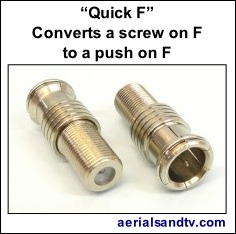CoAx plugs and F connectors
Subject list :
- Male or female / plug or socket ?
- Screw on or crimp on F connectors ?
- CoAx to F Conn adapters and couplers
- Right angle plugs
- Short of clearance for a right angle plug ?
- “Quick Fs”
Also see attaching / wiring up :
- CoAx Plugs
- Right angle CoAx plug
- F connectors

CoAx plugs and F conns
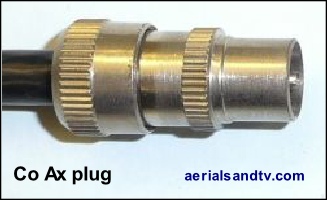
The CoAx plug (sold here) fits on the end of a TV aerial lead and it pushes in to the TV’s Co-Ax socket.
Note that most FM tuners actually have a male connectors, so in that case a female CoAx is needed (or a male with a Back to Back coupler).
Also see fitting a CoAx plug and fitting a right angle CoAx plug.
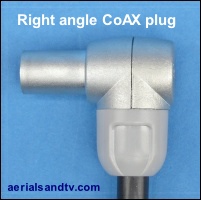
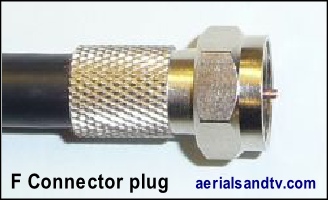
An F connector (sold here) is usually fitted on a lead from a satellite dish (or a DAB radio, a mast head amp or splitter) and it screws onto the socket. See fitting an F connector.
Note, right angle adapters (male to female) convert normal plugs to right angle plugs.
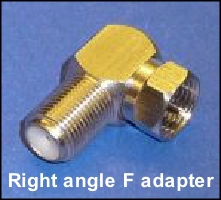
Here we have two types of F Connector. We stock the one on the right. It may be a little stronger but what is really worthwhile is the larger nut which make it far easier to tighten. Yet again, something so simple......
NOTE ! Decent quality F connectors are included with any of our splitters, amps or diplexers which require them.
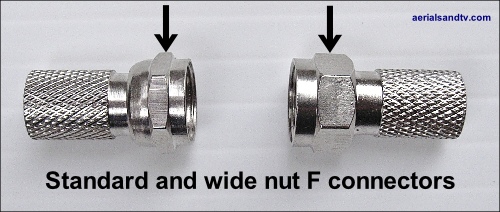
Push in CoAx plugs can be used for TV (UHF) or FM/DAB radio (VHF), though DAB actually uses F connectors in most cases. F connectors can also be used in place of CoAx plugs (assuming there is a corresponding F socket obviously ! ) but it is very bad practice to use CoAxial plugs/sockets for satellite work. Note, albeit rarely, CoAx connectors are sometimes called as "Belling Lee" connectors, and also, somewhat inaccurately, IEC connectors.
Co Axial plugs are more convenient (as they are quicker to connect) but an F connector gives a more robust and positive connection, this is particularly important in the case of connections which require power pass. That said, if your TV or amp has a CoAx input it is pointless putting an F connector on the end of a cable, then an F to Co-Ax adapter to turn it back into a CoAx. Just put a CoAx on it, let’s be honest, they’ve been perfectly OK for the last 50 years or so (make sure it’s a reasonably snug fit though) ! And if anyone tries to tell you that CoAx plugs are unsuitable for UHF frequencies or that their impedance isn’t 75 Ohms, believe me they’re talking bollocks. That said, it is true that the fact an F connector is screwed on does mean that the lead is less likely to become detached and furthermore the loss may be marginally lower than for a CoAx. Emphasis on the word marginal though.....
One sign of a good quality Co-Ax plug is if the "claw insert" is brass, as opposed to one of those horrible shiny metal ones which don’t seem to grip as well. We prefer brass plugs rather than alloy ones as they are more resistant to corrosion. The alloy ones can become difficult to undo over time, particularly if the atmosphere is damp or water has seeped down your aerial cable.
It is not advisable to reuse CoAx plugs as the "claw insert" becomes deformed when it is screwed up onto the cable, they aren’t that expensive anyway. If you have an intermittent signal it’s always worth checking the CoAx plug as a loose fitting one can cause this symptom, it may be a low quality plug or it was not even attached correctly in the first place ! Whilst checking the plug examine it for signs of water/dampness, this is usually caused by a damaged downlead, see “clipping cable to the slates”. I actually think fitting CoAx plugs correctly is not that easy, here is how to correctly fit a CoAx plug. The same applies to F conns. Alternatively we can attach the plugs for you at a small additional charge, see Custom Cables.
NOTE : It is not unknown for the nuts to pull off the body of F connectors (all F connectors…..), so our advice is order more than you need !
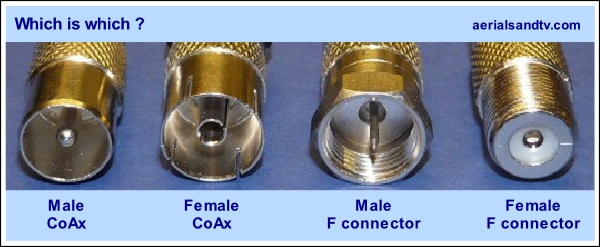
F Connectors, crimp on or screw on ?
We sometimes get people insisting that crimp on F connectors are superior to screw on types.
Well I have to say that from the electrical point of view there’s no difference between them at all.
As for "pull off strength" I have to admit that crimp on is a bit stronger, if it’s done right of course, but even with screw on Fs, assuming the correct F is used for the cable (they aren’t all the same, our F connectors are correct for our cable) it won’t pull off, not unless it’s subjected to a force it never ever should be.
Anyway, this is all totally irrelevant, because if you pulled hard enough on a correctly attached screw on F connector the nut would usually pull off the body long before the screwed on body pulls off the cable !
So why do many aerial installers use crimped on Fs ?
That’s nothing to do with the quality of the connection. It’s more to do with the fact an installer, particularly for system work, might have to put on hundreds of Fs per day, and for that crimping saves a hell of a lot of strain on your hands/wrists.
But I thought you were singing the praises of your Quality CoAx leads, mainly because they’ve got crimped on connectors ?
That’s correct. But that’s to do with the fact that plugs on cheap fly leads are moulded on and the centre core soldered, which can then break as the moulded plug flexes, therefore it’s a weak point. That problem doesn’t apply to screw on Fs.
Adapters and "back to back" couplers
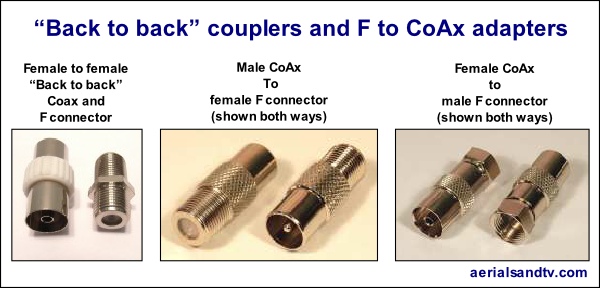
Various adapters are available to convert a F connector to a CoAx (male to female and reverse).
"Back to Back" joining couplers / "barrels" convert a Male Co Ax to a female CoAx, or a Male F to a Female F.
Note : we do not recommend female CoAx sockets (except right angle types) because the design of the “in line” type is not conducive to reliability. Very few trade aerial suppliers sell them either, and that’s got to tell you something.
It’s always worth having some back to back couplers around, they are a very useful diagnostic tool as they make it easy to bypass amplifiers or splitters.
"Right Angle" plug (or adapters) (Co Ax sold here and F Conn sold here) are available for use in confined spaces, remember sharp bends in CoAx cable are a bad idea, particularly immediately as it exits the plug. When considering the use of right angle connectors there is a theory that some can cause impedance mismatch with a consequent effect on the signal. So, if you do experience signal problems when using a right angle connector try temporarily eliminating it and see if the fault clears. I’d have thought most people wouldn’t find a problem, but it’s worth bearing in mind.
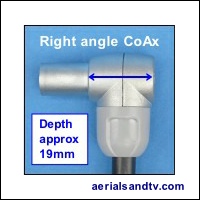
Short of clearance ?
Have you sufficient clearance (around the CoAx socket connector panel) on your TV to enable you to use a right angle plug ?
If not we suggest using a female right angle plug, then a male to male CoAX adapter. That will give about 1.5cm of additional clearance.
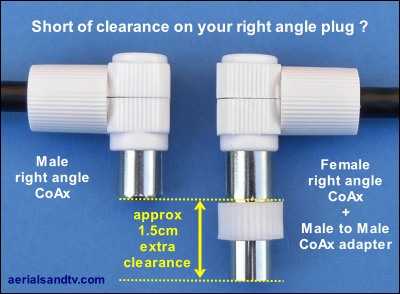
Finally, and almost ironically, there is the ”Quick F” adapter (sold here) to convert a screw F connector to a push F connector, i.e. a female screw on F to a male push in F.
Now I know what you’re thinking, isn’t this an abrogation of the whole point of F connectors (to give a better connection and also one which cannot be pulled apart) ?
Well yes, but these adapters are often used where the connection is screwed and unscrewed regularly, e.g. caravan based satellite systems, and also, if you think about it, satellite installers !
